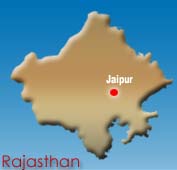Rajasthan''s Sambhar salt lake may soon cease to exist
 Rajasthan, Sep. 8 : Rajasthan''s famed Sambhar salt lake may soon become history following the absence of proper conservation plans and an acute shortage of labourers.
Rajasthan, Sep. 8 : Rajasthan''s famed Sambhar salt lake may soon become history following the absence of proper conservation plans and an acute shortage of labourers.
The lake, which is located about 110 kms from Rajasthan capital Jaipur, has been a good source for acquiring quality salt since the days of the British Raj.
It is said to be one of its kind in Asia.
The heritage lake requires immediate conservation, as it has acquired a reputation for producing the best salt in the country.
Scientifically it contains 99 percent sodium chloride and most Below Poverty Line (BPL) families living in the northern parts of the country rely on it for their immediate cooking needs.
This water source was first explored and tapped in 1800 by some Englishmen. Later, a commercial salt producing plant was set up in 1870.
Since then, this heritage lake has been producing and supplying salt to the northern parts of the country.
Over the last few years, the absence of a conservation plan has pushed the lake towards gradual extinction.
The catchments area or, the area from where the rainwater falls into the river of this lake, has shrunken its original shape. Apart from that too many encroachments in the vicinity have usurped the extensive stretches of land linked to the lake.
The worst periods are experienced during summers when the shortage of water hits a peak.
This summer has been no different, as the water catchment area of this salt lake has shrunk to a great extent.
Another factor contributing to the lake''s certain death is the rampant construction of many anicuts (dams) in catchment areas, which stop the inflow of rainwater to it during the monsoons.
Rainwater is the only source for filling this lake.
Villagers in the area tell even the labourers left this place due to acute water shortage.
"There should have been more progress in the lake and it should be filled with enough water through the water pumped from tube wells or else salt cannot be produced. There were a lot of labourers working here in the past but due to lack of water they have left the place," said Ghasidas, a villager of Rajas, which is located near the Sambhar Lake.
Besides, labourers are now looking towards the private sector industries that are coming up in and around the Pink City.
Residents of 38 villages surrounding the lake contend that government undertakings in the area do not provide them ample wages.
Even the major commercial salt manufacturing companies have felt the pinch of the exodus of skilled and unskilled labour force.
"Sambhar was the only place where the locals were dependant as for work but now they have diverted themselves to private companies who pay them better than us. Villages like Govindi, Rajas and Nawa are the places that have influenced the labour force. So we are now trying to bring them back through our new motives," said Anup Kumar, Assistant Manager, Hindustan Salt Limited.
The Sambhar lake is an extensive saline wetland, with water depths fluctuating from just a few centimeters as 60 cm during the dry season to about 3 meters (about 10 ft) after the monsoon season. It occupies an area of 190 to 230 square kilometers, based on the season. (ANI)